Blog
CHAPTER 2: Buyer Psychology
Buyer psychology deals with the understanding of why shoppers behave the way they do.
I’d like to share an example to show how online stores use buyer psychology to nudge shopper behavior.
I was on a mattress site this morning and saw this popup:
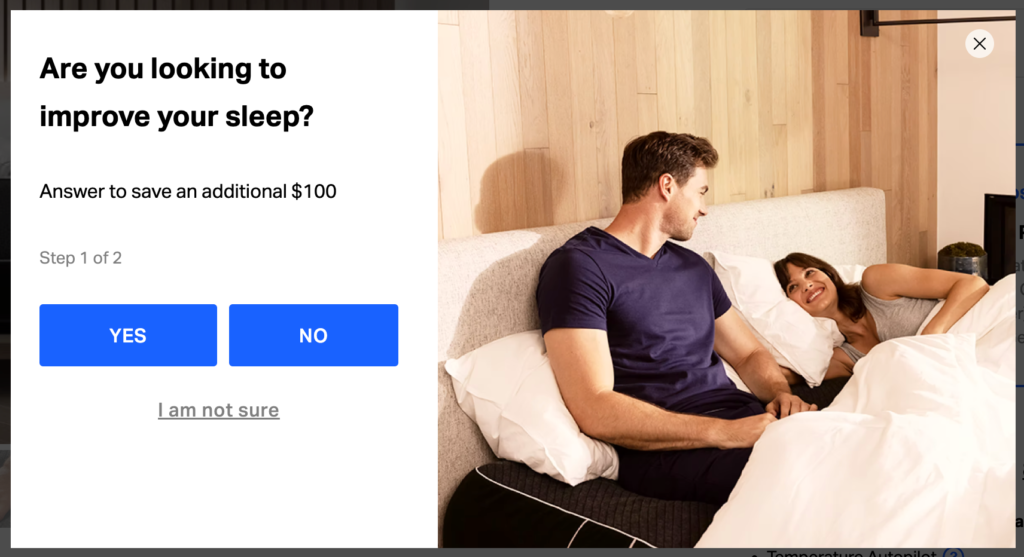
It’s reasonable to guess people shopping for a new mattress would be doing it because they care about the quality of sleep. So why add that extra step?
That’s because the retailer is using a buyer psychology principle.
By getting a small (easy) commitment on step 1 the retailer is able to make a bigger ask on the next screen:

Why Understanding Buyer Psychology Matters
First, a big ground rule – we AREN’T trying to trick the visitor. We’re living in a world of abundant choices. Google a pair of running shoes, air filters, coffee machines, health supplements, or a mattress and you are going to encounter a whole bunch of brands competing for your attention.
What’s true for other brands is true for yours too.
You know that rogue brands (who are trying to steal your customers) aren’t as good as yours, but shoppers don’t know that. The marketer’s job is to educate buyers on the differences and help them cross the finish line.
There are three buyer psychology trends impacting your marketing results. Marketers who understand these trends have an unfair advantage:
1: Site visitors aren’t sticking around. In 2020 Wolfgang Digital analyzed 130 million eCommerce site sessions and calculated the average session duration (time on site) was 2 minutes and 32 seconds (source).
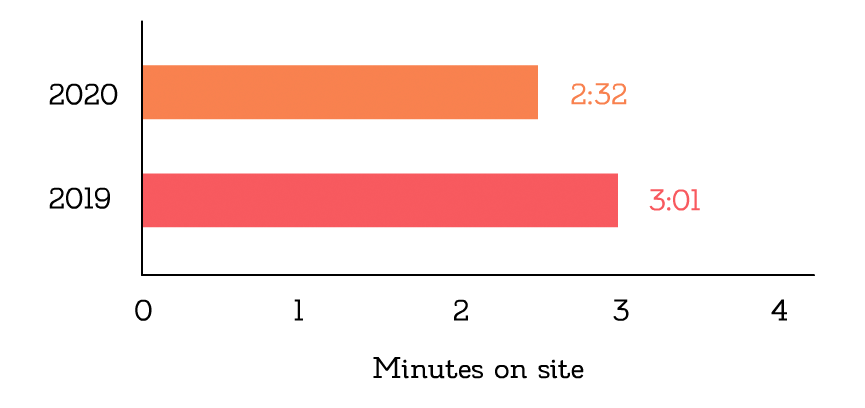
And with the explosive growth of TikTok, what will the time on site be like in 2025?
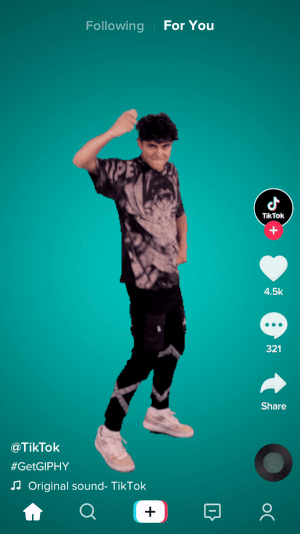
2: Less than 3% of ad traffic makes a purchase and only 38% ever returns. That’s infuriating.
3: There is increasing regulation around tracking users online. In 2021 Apple changed its default settings allowing Apple customers to block tracking data. This means sites can no longer track returning visitors in Apple-controlled environments.
Starting July 1, 2023, Google is no longer taking responsibility for holding your site visitor data.
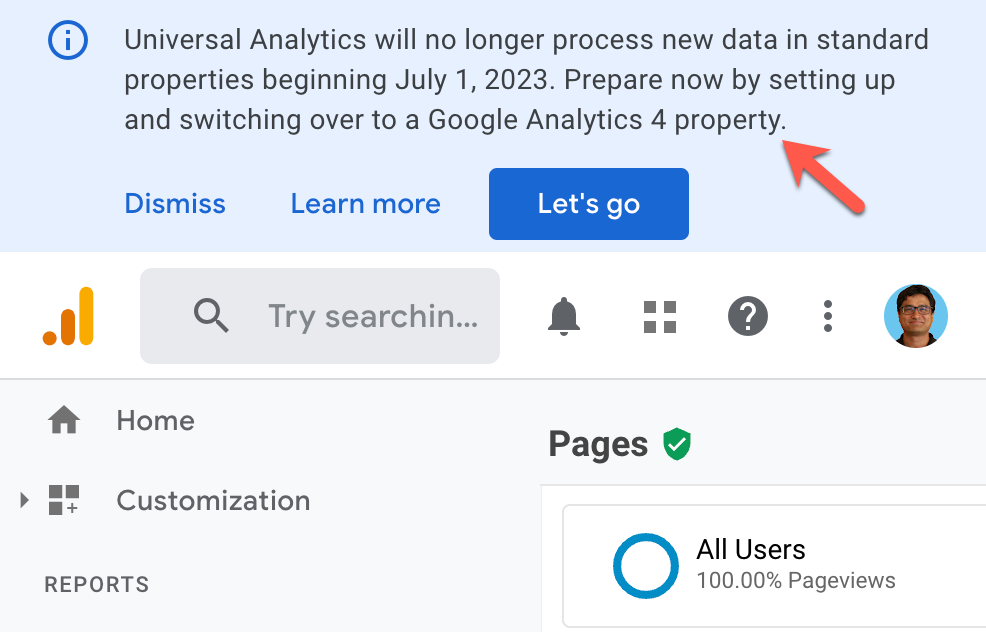
Bottom line: it’s more important than ever for the marketer to understand visitor buyer psychology and drive conversions on the first visit itself.
This is a big shift in thinking. A marketing plan built around the idea that shoppers visit multiple times before buying is completely different from one that recognizes the first visit is also the last.
But don’t worry, we have a solution in mind.
Are these 3 trends clear? /
🙌
Uh oh! Let's get in touch so I can explain this better.
We'll talk soon!
Next, we’re going to discuss a topic that won the Noble prize in economics.
Our Brains Like Shortcuts (System 1 vs System 2 Thinking)
Did you know the average online shopper is exposed to nearly 1,000 ads a day? (If each ad equates to just 3 seconds, that would push your ad viewing over 50 minutes per day!)
It simply isn’t possible to consider each ad and put together a pros and cons list to decide if an advertised product is worth it. Our brains are expensive devices– consuming 20% of our daily caloric intake.
To manage this chaos our brains have developed selection tricks.
There is one important detail we should mention here: System 2 is lazy. Incredibly lazy.
And this is by design. Thinking takes up significant brainpower. And evolution is all about smart energy usage. So the brain has millions of controls to manage energy usage. Using System 2 sparingly is at the core of this energy policy.
The policy is: for all simple decisions go to System 1. Only bother System 2 for the important stuff. The shoppers we are trying to influence are hanging out in System 1 mode.
Our goal is to align with System 1 when it comes to visitor behavior. That’s where the real conversions are happening.
Marketers who understand these tricks will win, and win big.
We explain System 1 and 2 modes in this important article: Shopper Psychology: System 1 Versus System 2. You should take a few minutes to read about System 1, but here’s a quick visual summary:
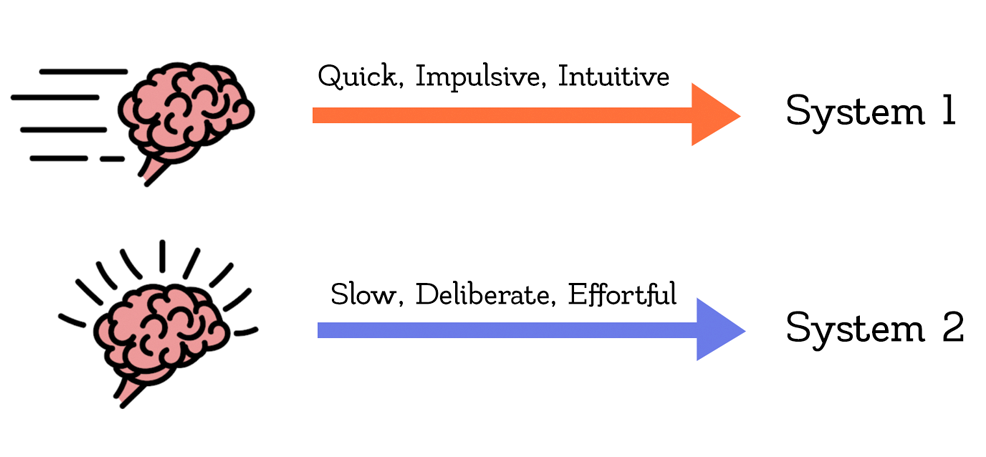
Capturing How Shoppers Behave Online
Online advertising today is quite different from what it was 100 years ago. Back then the advertiser would place an ad and have very little reliable performance analytics data (and they were more brand oriented, less direct sales oriented).
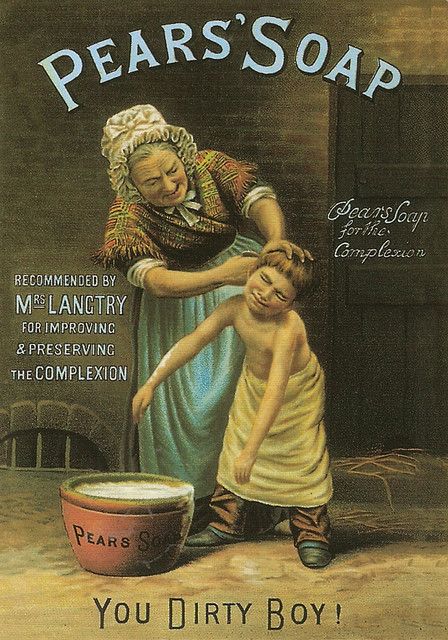
PEARS SOAP ADVERTISEMENT POSTCARD 1895
Lillie Langtry gave Pears soap her recommendation-apparently for no fee. Pears transparent soap is an old brand of soap, first produced commercially in 1789 by Andrew Pears. According to Unilever records, Pears Soap was the world’s first registered brand and is therefore the world’s oldest continually existing brand.
source
Today, advertisers are so much more sophisticated in terms of the precision of ad targeting and the data they collect. Marketing has become weaponized.
At the same time, it’s more democratized than ever. Where 100 years ago there were like 100 major advertisers today there are millions.
To win the buyer psychology game the marketer needs to focus– to channel attention.
Channeling Marketing Attention
Marketers want to do it all. They’re trying to:
– Develop marketing promotions.
– Manage advertising campaigns.
– Reactivate past buyers who haven’t bought in a while.
– Help drive up average order value because advertising is getting more and more expensive.
Basically, marketing teams are doing more than ever.
And while all the marketing tasks listed above are important, to win big the marketer needs to focus on a select few. You can’t do it all.
I focus my entire marketing attention on a very specific shopper– Healthy Skeptics.
What are Healthy Skeptics? How are they different from other types of buyers? I’m glad you asked because we have a whole article devoted to that topic: Focus on Converting Healthy Skeptics.
Now that we understand who Healthy Skeptics are, the next logical question is– how do we construct a sales pitch that gets them over the finish line?
This exact question is addressed next. It happens to be the subject we’ve spent 8 years studying.
The 9 Truths About Online Shoppers
Buyer psychology changes based on what’s being purchased. For example, the selection criteria for buying an electric toothbrush is quite different from what we use when choosing a new dishwasher, or men’s woolen running shoes.
But after running 100s of marketing experiments 🧪 we’ve seen a set of selection criteria that repeat across a huge range of consumer products.
These selection criteria operate at the subconscious level.
Pro tip: It’s a little bit like online dating!
You see, consumers aren’t able to analyze every marketing pitch they meet (they meet too many) so our brains have developed shortcuts to quickly reject bad pitches. But what criteria does the brain use to make such calls? That’s been a marketing mystery.
Imagine what would happen if marketers could crack the code on this selection criterion. That would be like discovering theRosetta Stone
Our Rosetta Stone moment: Through extensive experimentation, we were able to isolate nine mental checklist items (shortcuts) shoppers use when evaluating purchases (or mates 💍).
Here’s the list:
1: Shoppers are skeptical of too good to be true
2: They find expertise sexy
3: Root for people who beat the odds
4: Are fascinated by surprising details
5: Are visual animals
6: Need motivation to break habits
7: Love personalized experiences
8: Like knowing they’ve stumbled onto something rare
9: Must overcome their negative thoughts
Those nine truths along with practical examples are revealed in this in-depth The 9 Truths About Online Shoppers article.
Healthy Skeptics and the 9 Truths
We’ve just covered two very important topics. It’s important we understand how these how ideas relate. Here’s our process— when working on crafting copy for the 9 truths we’re looking at it from the Healthy Skeptic’s point of view. In fact, all copy we write is written for Healthy Skeptics.
The reason we focus so much on Healthy Skeptics is that any copy that convinces them (they are hard to please) will be 10x more impactful on our general site visitors. No tricks, just trust based on 9 proven principles.
Is this idea clear? /
🙌
Uh oh! Let's get in touch so I can explain this better.
We'll talk soon!
Next Steps
This concludes CHAPTER 2.
CHAPTER 3: Conversion Copywriting continues our journey. Here we’ll learn the history of copywriting, how it relates to buyer psychology and what it has to do with lawyers (crazy, but there is a connection, I promise). Ready?
CHAPTER 3: Conversion Copywriting.
Can’t wait? Or ready to jump on a call? >> Chapter 4.5: The Bottom Line




